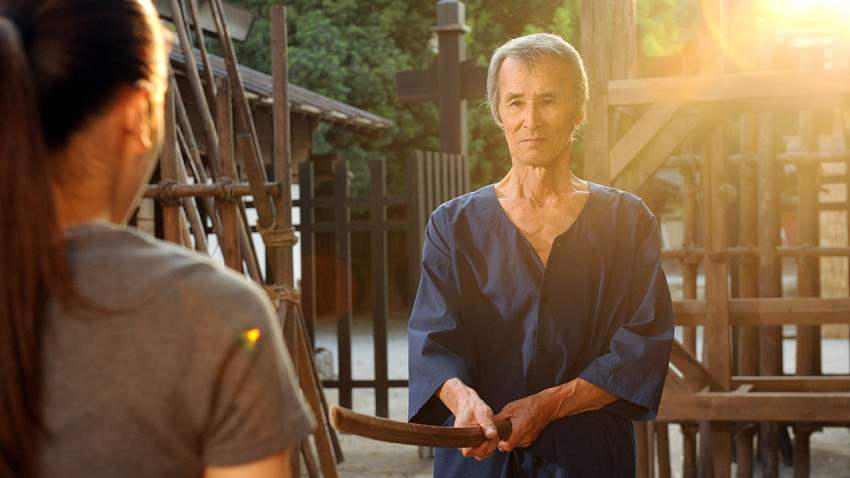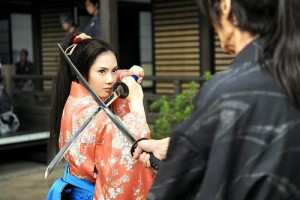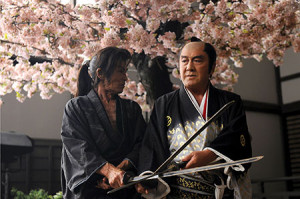Uzumasa Limelight
January 27, 2016 · 0 comments
By Jasper Sharp.
 Just a few stops to the west on the Sagano line from Kyoto lies the suburb of Uzumasa, an entertaining but curiously overlooked destination for tourists with more than a passing interest in Japan’s pop-cultural heritage. It is the site of Toei Kyoto Studio Park, commonly referred to by the locals as “Eiga Mura”, or the “Movie Village”, a theme park devoted to the world of jidai-geki (historical dramas set during the heyday of the samurai).
Just a few stops to the west on the Sagano line from Kyoto lies the suburb of Uzumasa, an entertaining but curiously overlooked destination for tourists with more than a passing interest in Japan’s pop-cultural heritage. It is the site of Toei Kyoto Studio Park, commonly referred to by the locals as “Eiga Mura”, or the “Movie Village”, a theme park devoted to the world of jidai-geki (historical dramas set during the heyday of the samurai).
Since the mid-1970s, visitors have been allowed to wander around its long-standing Edo-style sets, which for almost a hundred years have provided a historically-accurate backdrop to the swashbuckling action of some of Japan’s best-loved cinema and more recently TV. Opened by Nikkatsu in 1927, just a few years after the Great Kanto earthquake of 1923 temporarily prompted a mass migration of the major film companies from Tokyo to Kyoto, it was initially used for such classics as the final instalment of Daisuke Ito’s pioneering silent serial Chuji’s Travel Diary (1927) and other equally wonderful titles from this director such as Blood-Spattered at Takadanobaba (1928). A historical split soon emerged, with the old capital remaining as the base of production for those working with traditional feudal fare, while new studios, subsequently re-established in the Kanto area around Tokyo, predominantly dedicated their facilities to modern dramas.
Uzumasa passed into the hands of Toei when the company first began functioning in its current form in 1951, churning out literally hundreds of historical actioners across the decade. In the 1960s, Toei began to shift its period productions to the new small-screen medium of television, establishing the subsidiary Toei Television in 1958, while refocusing its cinematic output on other areas, most notably the yakuza genre and anime, through its Toei Animation department launched in 1956.
Despite the occasional resurgence in its fortunes, period drama today is a distant echo of its 1970s heyday. Much like the American cowboy, the screen samurai is comparatively little in demand now. Visitors to the Uzumasa film set can still delight in meticulously choreographed ninja shows and sword battles, but increasingly less often nowadays do these dramatic scenes turn up on TV or movie screens. Toei’s movie village is now arguably little more than a living museum.
 Ken Ochiai’s Uzumasa Limelight, to be released in the United Kingdom by Third Window Films and shortly to play at selected venues across the country as part of the Japan Foundation’s annual touring season, shines light on the most loyal of the studio retainers who have suffered from the waning interest in this most traditional of Japanese genres. The opening credits inform us that Uzumasa was once known as the “Hollywood of the East” and in its glory days provided a home to over a hundred kirare-yaku: highly-skilled extras who specialise in being killed onscreen. Nowadays their numbers have dwindled to a mere handful, and those who remain are long past their prime.
Ken Ochiai’s Uzumasa Limelight, to be released in the United Kingdom by Third Window Films and shortly to play at selected venues across the country as part of the Japan Foundation’s annual touring season, shines light on the most loyal of the studio retainers who have suffered from the waning interest in this most traditional of Japanese genres. The opening credits inform us that Uzumasa was once known as the “Hollywood of the East” and in its glory days provided a home to over a hundred kirare-yaku: highly-skilled extras who specialise in being killed onscreen. Nowadays their numbers have dwindled to a mere handful, and those who remain are long past their prime.
One such figure is Kamiyama, wonderfully played by the 71-year-old Seizo Fukumoto, himself a bit-player since the late-1950s whose endless parade of low-billed screen credits wouldn’t have been enough to justify a Wikipedia entry until this career-defining turn.
After diligently going about his business for decades, Kamiyama finds his career killed off once and for all when the studio’s ruthlessly ratings-obsessed executive Kawashima announces the cancellation of his long-running fixture in the TV schedules, The Saga of Edo Zakura – echoes here, perhaps, of the controversial cancellation of Mito Komon in 2011. Opportunities for him and all his kirare-yaku colleagues are thin on the ground as the company puts its resources into the detective drama The Kyoto Tea Stem Murder Case. Even when a new flagship samurai series for a younger generation of viewers is announced, delight turns to despair as it is revealed that the main role is to go to a preening boy-band idol and rapidly-edited CG skirmishes are to replace the skilful displays of onscreen swordsmanship honed across Kamiyama’s own working life. As he is shuffled off as one of the more quaint attractions in the studio’s movie theme park, the future not only looks bleak for Kamiyama, but the entire future of Kyoto’s industry veterans.
 Uzumasa Limelight joins Yoji Yamada’s Kyoto Uzumasa Monogatari (2010) as the latest nostalgia trip to checklist the historical studio, although the English release title of the earlier docudrama, Kyoto Story, removes the overt reference. (We’ve also had Moriro Miyamoto’s rather less reverential indie oddity Uzumasa Jacopetti from 2013, whose simultaneous nod to the Italian producer of the seminal shockumentary Mondo Cane reveals its heart to be in rather a different place).
Uzumasa Limelight joins Yoji Yamada’s Kyoto Uzumasa Monogatari (2010) as the latest nostalgia trip to checklist the historical studio, although the English release title of the earlier docudrama, Kyoto Story, removes the overt reference. (We’ve also had Moriro Miyamoto’s rather less reverential indie oddity Uzumasa Jacopetti from 2013, whose simultaneous nod to the Italian producer of the seminal shockumentary Mondo Cane reveals its heart to be in rather a different place).
Realised by an LA-based Japanese director and production company, Uzumasa Limelight seems to hint that the glorious swordplay movies of yore are better appreciated by overseas audiences than local ones. The film won the Cheval Noir award for best film at the 2014 Fantasia International film festival in Montreal, with the best actor award going to Fukumoto, and has subsequently met with a positive reception at various other festivals across the world.
There is the occasional tendency to tip over into the more sentimental territory of contemporary Japanese drama, and there are a number of cineaste references that will fly over the heads of both overseas and many contemporary Japanese viewers (the main star of the cancelled show, Onoe, shares his name with Japan’s earliest star of the silver screen Onoe Matsunosuke, who reigned over the genre during the 1910s and 20s). Uzumasa Limelight also feels rather conventionally staged compared with the more dynamic samurai offerings of the genre’s cinematic heyday, although perhaps justifiably so, given that its reference point is television.
Still, there are some nice stylistic flourishes, such as the opening battle scene, its fighters silhouetted behind the grid-like patterns of interior shoji screens before one collapses through one of the panels to reveal the camera crew behind it. Taken as a whole ,it is the human heart beneath this celebration of old-school virtues and the industry’s unsung stalwarts that ultimately wins one over. Uzumasa Limelight is one of the most accessible and affecting reminders of the enduring appeal of Japanese cinema in recent years, and provides a perfectly-timed spur for further exploring its history.
Uzumasa Limelight is screening in a dozen UK cities as part of the Japan Foundation’s touring programme this spring, along with other movies including Miss Hokusai and Anthem of the Heart.
Eiga Mura, film, Japan, Japan Foundation, Jasper Sharp, Ken Ochiai, live-action, Uzumasa, Uzumasa Limelight
Leave a Reply